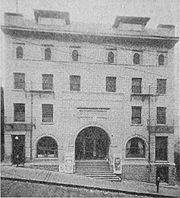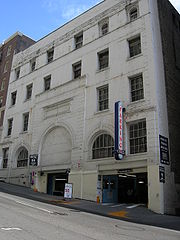
Grand Opera House (Seattle)
Encyclopedia



Seattle, Washington
Seattle is the county seat of King County, Washington. With 608,660 residents as of the 2010 Census, Seattle is the largest city in the Northwestern United States. The Seattle metropolitan area of about 3.4 million inhabitants is the 15th largest metropolitan area in the country...
, USA
United States
The United States of America is a federal constitutional republic comprising fifty states and a federal district...
, designed by Seattle architect Edwin W. Houghton, a leading designer of Pacific Northwest
Pacific Northwest
The Pacific Northwest is a region in northwestern North America, bounded by the Pacific Ocean to the west and, loosely, by the Rocky Mountains on the east. Definitions of the region vary and there is no commonly agreed upon boundary, even among Pacific Northwesterners. A common concept of the...
theaters, was once the city's leading theater. Today, only its exterior survives as the shell of a car park
Parking lot
A parking lot , also known as car lot, is a cleared area that is intended for parking vehicles. Usually, the term refers to a dedicated area that has been provided with a durable or semi-durable surface....
. Considered by the city's Department of Neighborhoods to be an example of Richardsonian Romanesque
Richardsonian Romanesque
Richardsonian Romanesque is a style of Romanesque Revival architecture named after architect Henry Hobson Richardson, whose masterpiece is Trinity Church, Boston , designated a National Historic Landmark...
, the building stands just outside the northern boundary of the Pioneer Square
Pioneer Square, Seattle, Washington
Pioneer Square is a neighborhood in the southwest corner of Downtown Seattle, Washington, USA. It was once the heart of the city: Seattle's founders settled there in 1852, following a brief six-month settlement at Alki Point on the far side of Elliott Bay. The early structures in the neighborhood...
neighborhood.
The building at 213–217 Cherry Street, Seattle, Washington was originally owned by John Cort, of Cort Circuit fame. Opened in 1900, after Cort convinced the city to extend the northern border of its official entertainment district north from Yesler Way to Cherry Street, it was the city's leading theater of the time. It survived a November 24, 1906 fire, but after it was gutted by another fire in 1917, it was converted to a parking garage in 1923.
The reign of the Grand as Seattle's leading theater was relatively short. Cort himself was one of the reasons for this, when he made Seattle's Moore Theatre
Moore Theatre (Seattle, Washington)
The Moore Theatre in Seattle, Washington, U.S.A. is a 1,419-seat performing arts venue located at the corner of 2nd Avenue and Virginia Street, two blocks from Pike Place Market in downtown Seattle. It is the oldest still-active theater in Seattle. The Moore hosts a mix of theatrical productions,...
, also designed by Houghton, his flagship house after its December 28, 1907 opening. The 1911 opening of the showpiece Metropolitan Theatre in the Metropolitan Tract further eroded the Grand's position. By the time a January 20, 1917 fire gutted the building, it had become a movie theater.
After the 1917 fire, the building sat empty for several years before becoming a multi-level parking garage in 1923.
Theater
The Grand Opera House was constructed 1898-1900. Nearby at Third Avenue and Cherry Street, John ConsidineJohn Considine (Seattle)
John Considine was an American impresario, a pioneer of vaudeville.-Youth and arrival on the scene:Born in Chicago, Considine grew up attending Roman Catholic parochial schools, and eventually briefly attended St. Mary's College, Kansas. Briefly a Chicago policeman, he was involved in the raid...
, a veteran of box house
Box house
A box house was a combination of low-class theater and brothel, found in western North America in the late 19th and early 20th century. It offered light entertainment "such as magic acts, singing, dancing, minstrel shows," as well as sexual services...
days and a pioneer of vaudeville
Vaudeville
Vaudeville was a theatrical genre of variety entertainment in the United States and Canada from the early 1880s until the early 1930s. Each performance was made up of a series of separate, unrelated acts grouped together on a common bill...
had his highly successful Seattle Theater. The basement level of the Grand opened as a variety
Variety show
A variety show, also known as variety arts or variety entertainment, is an entertainment made up of a variety of acts, especially musical performances and sketch comedy, and normally introduced by a compère or host. Other types of acts include magic, animal and circus acts, acrobatics, juggling...
and beer hall known as the Palm Gardens before the building was otherwise finished.
The stage of the Grand was 30 feet (9.1 m) and 72 feet (21.9 m) wide. Two tiers of boxes stood six on each side of the proscenium. There was also a balcony. In all, the highly ornate auditorium had a capacity of 2,200 people. The St. Charles/Rector Hotel was constructed next door on Third Avenue in 1912-13; it was originally interconnected to the opera house at the balcony level.
Parking garage
In March 1923, new owners Victor Elfendal and W.W. Scrubby decided that the Grand would be converted to use as a parking garage. Schack, Young and Myers, a major Seattle architectural firm, effected the conversion. The Seattle Department of Neighborhoods asserts that this relatively intact and early example of a commercial parking garage has historic significance, independent of the building's historic significance as Downtown Seattle's oldest surviving structure initially designed as a theater. As Seattle's commercial core began to grow and as the automobile began to shape the city, "large parking garages…were a lucrative and essential part of downtown commerce."The structure
The building is a 5-story brick masonry structure in Richardsonian RomanesqueRichardsonian Romanesque
Richardsonian Romanesque is a style of Romanesque Revival architecture named after architect Henry Hobson Richardson, whose masterpiece is Trinity Church, Boston , designated a National Historic Landmark...
style, not counting a foundation and basement. It measures 77 feet (23.5 m) x 120 feet (36.6 m). The theater interior is entirely destroyed, and the façade is much altered, but some original exterior features remain under white paint. The original red brick cladding has been painted over, as have the ornamental quoin
Quoin (architecture)
Quoins are the cornerstones of brick or stone walls. Quoins may be either structural or decorative. Architects and builders use quoins to give the impression of strength and firmness to the outline of a building...
s and the remaining portions of the original sandstone
Sandstone
Sandstone is a sedimentary rock composed mainly of sand-sized minerals or rock grains.Most sandstone is composed of quartz and/or feldspar because these are the most common minerals in the Earth's crust. Like sand, sandstone may be any colour, but the most common colours are tan, brown, yellow,...
trim. According to the Department of Neighborhoods, surviving sandstone features include "the former entry vestibule arch, the arched openings with keystones at the second floor level windows, the upper floor level window sills and watertable. Painted original sandstone trim also accentuates the former name plaque above the entry vestibule arch and the cap of the central raised entry bay."
The building retains all of its original window openings. The two large openings at the first floor level date from the parking garage conversion. At the east end of the second floor, a former door opening to the ticket booth became a window opening: creating the garage entry and exit meant removing the entry stairway, which (according, again, to the Department of Neighborhoods) "reportedly was accented by Vermont
Vermont
Vermont is a state in the New England region of the northeastern United States of America. The state ranks 43rd in land area, , and 45th in total area. Its population according to the 2010 census, 630,337, is the second smallest in the country, larger only than Wyoming. It is the only New England...
blue marble." Originally, the garage retained raised corner parapets and a prominent cornice; these have been lost. The industrial steel sash windows from 1923 remain.
External links
- Eric L. Flom, Fire burns Seattle's Grand Opera House on November 24, 1906, HistoryLink, September 7, 2000. Includes historical pictures.

